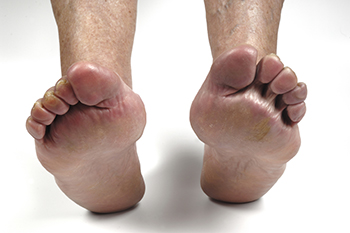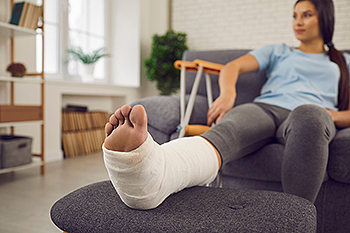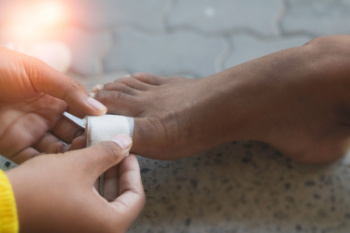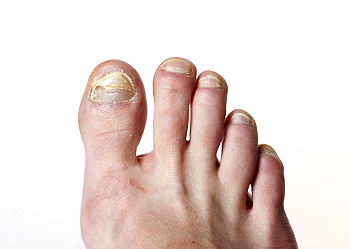Items filtered by date: September 2024
It's Time for Beautiful Feet
How Rheumatoid Arthritis Affects the Feet

Rheumatoid arthritis, or RA, is an inflammatory condition that commonly affects the joints, including those in the feet. People with RA often experience symptoms such as pain, swelling, and stiffness in the smaller joints of the toes and forefoot. Over time, if not properly managed, this can lead to joint deformities, nodules, and even altered foot shape. Foot issues from rheumatoid arthritis can affect mobility and quality of life, making it harder to perform daily activities. A podiatrist can help alleviate discomfort by prescribing custom orthotics, addressing inflammation, and offering treatments to slow joint damage. They can also address associated skin problems, like corns and calluses, which often develop from pressure points on the feet. Early intervention and continuous care are essential to prevent further complications. If you have foot pain related to rheumatoid arthritis, it is suggested that you make an appointment with a podiatrist for an exam, diagnosis, and treatment options.
Because RA affects more than just your joints, including the joints in your feet and ankles, it is important to seek early diagnosis from your podiatrist if you feel like the pain in your feet might be caused by RA. For more information, contact one of our podiatrists of Summit Podiatry. Our doctors will assist you with all of your podiatric concerns.
What Is Rheumatoid Arthritis?
Rheumatoid Arthritis (RA) is an autoimmune disorder in which the body’s own immune system attacks the membranes surrounding the joints. Inflammation of the lining and eventually the destruction of the joint’s cartilage and bone occur, causing severe pain and immobility.
Rheumatoid Arthritis of the Feet
Although RA usually attacks multiple bones and joints throughout the entire body, almost 90 percent of cases result in pain in the foot or ankle area.
Symptoms
- Swelling and pain in the feet
- Stiffness in the feet
- Pain on the ball or sole of feet
- Joint shift and deformation
Diagnosis
Quick diagnosis of RA in the feet is important so that the podiatrist can treat the area effectively. Your doctor will ask you about your medical history, occupation, and lifestyle to determine the origin of the condition. Rheumatoid Factor tests help to determine if someone is affected by the disease.
If you have any questions please feel free to contact one of our offices located in Wilmington, Whiteville, and Wallace, NC . We offer the newest diagnostic and treatment technologies for all your foot and ankle needs.
Treatment for a Medial Malleolus Fracture

A medial malleolus fracture is a specific type of broken ankle. The medial malleolus is the bony prominence on the inner side of your ankle, part of the tibia, or shinbone. When this bone becomes fractured it often occurs due to a twist, fall, or direct impact to the ankle. Symptoms typically include sharp pain on the inside of the ankle, swelling, bruising, and difficulty bearing weight on the affected foot. Treatment for this type of fracture depends on the severity of the break. For minor fractures where the bone is still aligned, a podiatrist might immobilize the ankle in a cast or boot to allow it to heal. However, if the fracture is displaced, surgery might be necessary to realign and stabilize the bone with screws or plates. If you have broken any part of your ankle, it is strongly suggested that you visit a podiatrist for a proper diagnosis and treatment.
Broken ankles need immediate treatment. If you are seeking treatment, contact one of our podiatrists from Summit Podiatry. Our doctors can provide the care you need to keep you pain-free and on your feet.
Broken Ankles
A broken ankle is experienced when a person fractures their tibia or fibula in the lower leg and ankle area. Both of these bones are attached at the bottom of the leg and combine to form what we know to be our ankle.
When a physician is referring to a break of the ankle, he or she is usually referring to a break in the area where the tibia and fibula are joined to create our ankle joint. Ankles are more prone to fractures because the ankle is an area that suffers a lot of pressure and stress. There are some obvious signs when a person experiences a fractured ankle, and the following symptoms may be present.
Symptoms of a Fractured Ankle
- Excessive pain when the area is touched or when any pressure is placed on the ankle
- Swelling around the area
- Bruising of the area
- Area appears to be deformed
If you suspect an ankle fracture, it is recommended to seek treatment as soon as possible. The sooner you have your podiatrist diagnose the fracture, the quicker you’ll be on the way towards recovery.
If you have any questions, please feel free to contact one of our offices located in Wilmington, Whiteville, and Wallace, NC . We offer the newest diagnostic and treatment technologies for all your foot care needs.
Caring for Foot Blisters

Foot blisters are small, fluid-filled pockets that form on the skin due to friction, pressure, or irritation. They commonly occur while wearing ill-fitting shoes, during extended periods of walking or running, or when feet are exposed to moisture, which softens the skin and increases the risk of blistering. Symptoms include a raised, fluid-filled bump that can be painful when pressed or irritated. The skin surrounding the blister may appear red and inflamed. To prevent blisters, wear properly fitting shoes, and moisture-wicking socks, and consider applying blister prevention tape to high-friction areas. Keep your feet dry and change socks regularly if they become wet. If a blister forms, avoid popping it to reduce the risk of infection. Instead, cover it with a clean bandage and allow it to heal naturally. If you have a blister that is particularly painful or large, it is suggested that you consult a podiatrist for treatment.
Blisters may appear as a single bubble or in a cluster. They can cause a lot of pain and may be filled with pus, blood, or watery serum. If your feet are hurting, contact one of our podiatrists of Summit Podiatry. Our doctors can provide the care you need to keep you pain-free and on your feet.
Foot Blisters
Foot blisters are often the result of friction. This happens due to the constant rubbing from shoes, which can lead to pain.
What Are Foot Blisters?
A foot blister is a small fluid-filled pocket that forms on the upper-most layer of the skin. Blisters are filled with clear fluid and can lead to blood drainage or pus if the area becomes infected.
Symptoms
(Blister symptoms may vary depending on what is causing them)
- Bubble of skin filled with fluid
- Redness
- Moderate to severe pain
- Itching
Prevention & Treatment
In order to prevent blisters, you should be sure to wear comfortable shoes with socks that cushion your feet and absorb sweat. Breaking a blister open may increase your chances of developing an infection. However, if your blister breaks, you should wash the area with soap and water immediately and then apply a bandage to the affected area. If your blisters cause severe pain it is important that you call your podiatrist right away.
If you have any questions, please feel free to contact one of our offices located in Wilmington, Whiteville, and Wallace, NC . We offer the newest diagnostic and treatment technologies for all your foot care needs.
Definition and Risk Factors for Toenail Fungus

Toenail fungus, or onychomycosis, is a common infection characterized by changes in the appearance of the toenail. It often begins with discoloration, turning the nail yellow, white, or brown, and may lead to thickening, crumbling, or detachment of the nail. The fungus thrives in warm, damp environments, making it more likely to develop if feet are frequently exposed to moisture or if proper hygiene is not maintained. Risk factors include having a weakened immune system, wearing tight or non-breathable shoes, and having diabetes, which also increases susceptibility to infections. Identifying toenail fungus early is vital for effective treatment, which can include antifungal medications and improved foot care practices. If you have developed toenail fungus, it is strongly suggested that you are under the care of a podiatrist who can prescribe medication for effective treatment.
If left untreated, toenail fungus may spread to other toenails, skin, or even fingernails. If you suspect you have toenail fungus it is important to seek treatment right away. For more information about treatment, contact one of our podiatrists of Summit Podiatry. Our doctors can provide the care you need to keep you pain-free and on your feet.
Symptoms
- Warped or oddly shaped nails
- Yellowish nails
- Loose/separated nail
- Buildup of bits and pieces of nail fragments under the nail
- Brittle, broken, thickened nail
Treatment
If self-care strategies and over-the-counter medications does not help your fungus, your podiatrist may give you a prescription drug instead. Even if you find relief from your toenail fungus symptoms, you may experience a repeat infection in the future.
Prevention
In order to prevent getting toenail fungus in the future, you should always make sure to wash your feet with soap and water. After washing, it is important to dry your feet thoroughly especially in between the toes. When trimming your toenails, be sure to trim straight across instead of in a rounded shape. It is crucial not to cover up discolored nails with nail polish because that will prevent your nail from being able to “breathe”.
In some cases, surgical procedure may be needed to remove the toenail fungus. Consult with your podiatrist about the best treatment options for your case of toenail fungus.
If you have any questions, please feel free to contact one of our offices located in Wilmington, Whiteville, and Wallace, NC . We offer the newest diagnostic and treatment technologies for all your foot care needs.

